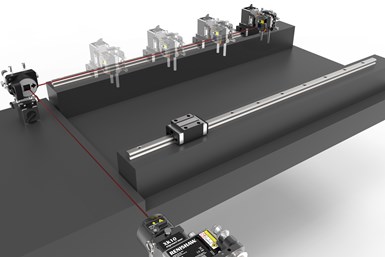Renishaw's Alignment System Precisely Measures Parallelism
The XK10 alignment laser system achieves precise adjustments to machine parallelism at a level that was previously impossible with traditional measurement techniques.
Share




Renishaw has released a new version of software for its XK10 alignment laser system that enables users to perform point-to-point parallelism measurements. According to the company, this functionality achieves precise adjustments to machine parallelism at a level that was previously impossible with traditional measurement techniques.
The XK10 alignment laser system is a precise measurement tool for straightness, squareness, rotational parallelism, rail parallelism, flatness and level. It is also capable of assessing spindle direction and coaxiality of rotary machines, as well as diagnosing the source of errors following a rebuild or as part of regular maintenance.
The XK10 uses laser measurements to capture two points on each rail, enabling the angle between the two rails to be determined and recorded digitally. It is designed to be simpler and more precise than similar manual processes.
Andy Deacon, calibration product manager at Renishaw, says that the system measures at multiple points while also measuring the straightness of each rail. These measurements can be used determine parallelism between rails to a high degree of precision.
Renishaw's calibration products, including the XL-80 laser interferometer, QC20-W ballbar and XM-60 multi-axis calibrator, are designed to enable users to better gauge how a machine is performing. The Carto software suite provides data capture, analysis and compensation applications, which is meant to simplify the process for monitoring and improve position performance.
Related Content
-
Rethink Quality Control to Increase Productivity, Decrease Scrap
Verifying parts is essential to documenting quality, and there are a few best practices that can make the quality control process more efficient.
-
The Many Ways of Measuring Thickness
While it may seem to be a straightforward check, there are many approaches to measuring thickness that are determined by the requirements of the part.
-
Turning Fixed-Body Plug Gages Inside Out
Fixed-body mechanical plug gages provide fast, high-performance measurement for tight-tolerance holes.


























